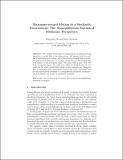Maximum-Reward Motion in a Stochastic Environment: The Nonequilibrium Statistical Mechanics Perspective
Author(s)
Ma, Fangchang; Karaman, Sertac
DownloadHow_Maximum-reward.pdf (658.0Kb)
OPEN_ACCESS_POLICY
Open Access Policy
Creative Commons Attribution-Noncommercial-Share Alike
Terms of use
Metadata
Show full item recordAbstract
We consider the problem of computing the maximum-reward motion in a reward field in an online setting. We assume that the robot has a limited perception range, and it discovers the reward field on the fly. We analyze the performance of a simple, practical lattice-based algorithm with respect to the perception range. Our main result is that, with very little perception range, the robot can collect as much reward as if it could see the whole reward field, under certain assumptions. Along the way, we establish novel connections between this class of problems and certain fundamental problems of nonequilibrium statistical mechanics . We demonstrate our results in simulation examples.
Date issued
2015-04Department
Massachusetts Institute of Technology. Department of Aeronautics and AstronauticsJournal
Algorithmic Foundations of Robotics XI
Publisher
Springer International Publishing
Citation
Ma, Fangchang, and Sertac Karaman. “Maximum-Reward Motion in a Stochastic Environment: The Nonequilibrium Statistical Mechanics Perspective.” Algorithmic Foundations of Robotics XI. Ed. H. Levent Akin et al. Vol. 107. Cham: Springer International Publishing, 2015. 389–406.
Version: Author's final manuscript
ISBN
978-3-319-16594-3
978-3-319-16595-0
ISSN
1610-7438
1610-742X